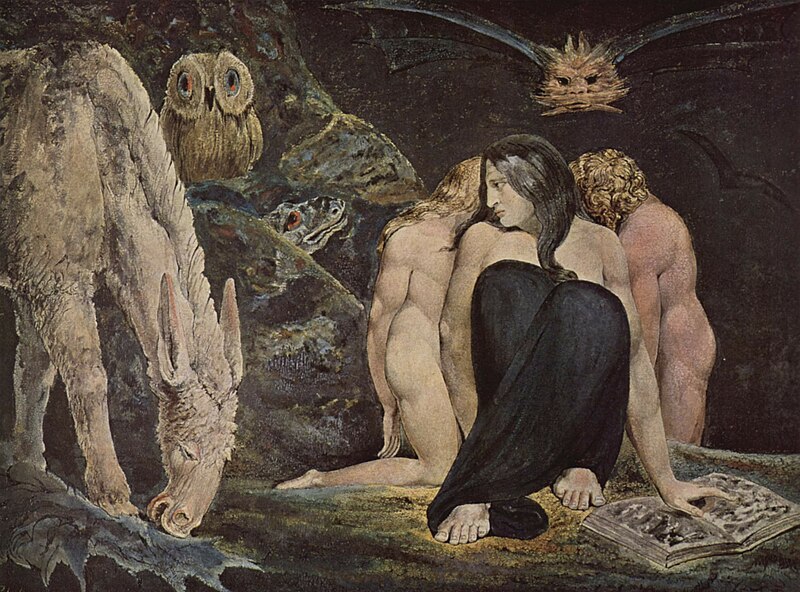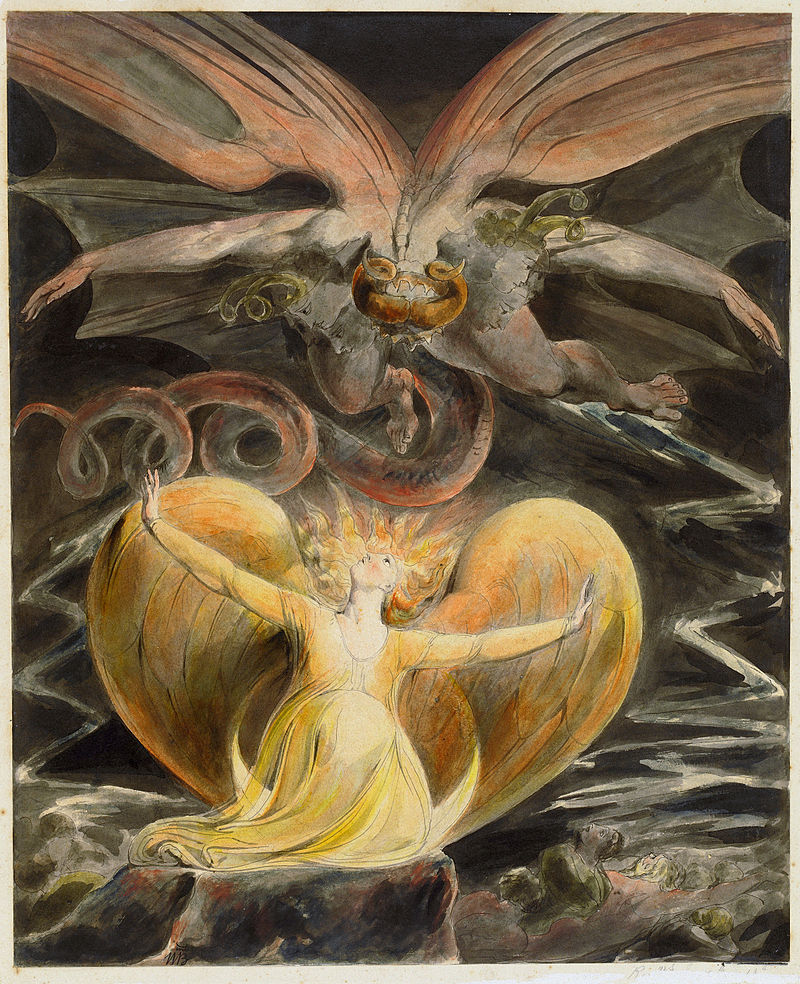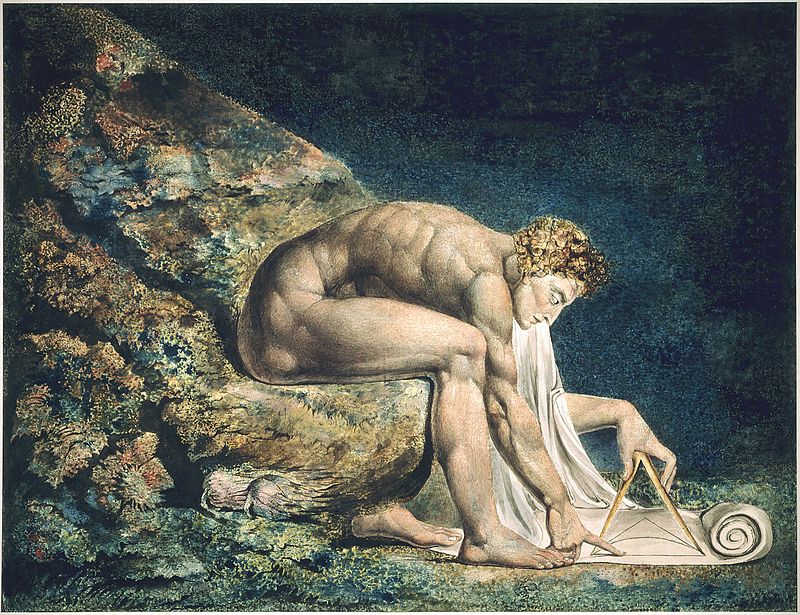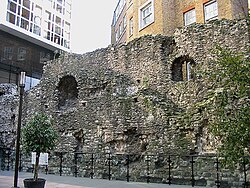"William Blake was born on 28 November 1757 at 28 Broad Street (now Broadwick St.) in Soho, London. He was the third of seven children, two of whom died in infancy. Blake's father, James, was a hosier.
He attended school only long enough to learn reading and writing, leaving at the age of ten, and was otherwise educated at home by his mother Catherine Blake (née Wright"
https://en.wikipedia.org/wiki/William_Blake


"Europe Supported by Africa and America (1st December 1792) engraving by William Blake
"When William was ten years old, his parents knew enough of his headstrong temperament that he was not sent to school but instead enrolled in drawing classes at Pars's drawing school in the Strand.[19] He read avidly on subjects of his own choosing. During this period, Blake made explorations into poetry; his early work displays knowledge of Ben Jonson, Edmund Spenser, and the Psalms."

"The Night of Enitharmon's Joy, 1795; Blake's vision of Hecate, Greek goddess of black magic and the underworld"
"Hence, bat, owl, snake or frog would be appropriate to The Triple Hecate"
""She is triple, according to mythology: a girl and a boy hide their heads behind her back. Her left hand lies on a book of magic; her left foot is extended. She is attended by a
thistle-eating ass,
the mournful owl of false wisdom,
the head of a crocodile (blood-thirsty hypocrisy), Tu quoque
and a cat-headed bat
"On 4 August 1772, Blake was apprenticed to engraver James Basire of Great Queen Street, at the sum of £52.10, for a term of seven years.
At the end of the term, aged 21, he became a professional engraver. No record survives of any serious disagreement or conflict between the two during the period of Blake's apprenticeship, but Peter Ackroyd's biography notes that Blake later added Basire's name to a list of artistic adversaries – and then crossed it ouuuuuuut"


"Blake's first collection of poems, Poetical Sketches, was printed around 1783.[31] After his father's death, Blake and former fellow apprentice James Parker opened a print shop in 1784, and began working with radical publisher Joseph Johnson.[32] Johnson's house was a meeting-place for some leading English intellectual dissidents of the time: theologian and scientist Joseph Priestley, philosopher Richard Price, artist John Henry Fuseli,[33] early feminist Mary Wollstonecraft and English revolutionary Thomas Paine. Along with William Wordsworth and William Godwin, Blake had great hopes for the French and American revolutions and wore a Phrygian cap in solidarity with the French revolutionaries, but despaired with the rise of Robespierre and the Reign of Terror in France. In 1784 Blake composed his unfinished manuscript An Island in the Moon.

"From 1790 to 1800, William Blake lived in North Lambeth, London, at 13 Hercules Buildings, Hercules Road.[34] The property was demolished in 1918, but the site is now marked with a plaque."

"Although Blake's attacks on conventional religion were shocking in his own day, his rejection of religiosity was not a rejection of religion per se. His view of orthodoxy is evident in The Marriage of Heaven and Hell. Therein, Blake lists several Proverbs of Hell, among which are the following:
"Prisons are built with stones of Law,
Brothels with bricks of Religion."
"As the catterpillar [sic] chooses the fairest leaves to lay her eggs on,
so the priest lays his curse on the fairest joys. "
(8.21, 9.55, E36)

"Blake designed his own mythology, which appears largely in his prophetic books. Within these he describes a number of characters, including "Urizen", "Enitharmon", "Bromion" and "Luvah". His mythology seems to have a basis in the Bible as well as Greek and Norse mythology,"

"Blake opposed the sophistry of theological thought that excuses pain, admits evil and apologises for injustice. He abhorred self-denial,[85] which he associated with religious repression and particularly sexual repression:"

" Blake is sometimes considered (along with Mary Wollstonecraft and her husband William Godwin) a forerunner of the 19th-century "free love" movement, a broad reform tradition starting in the 1820s that held that marriage is slavery, and advocated the removal of all state restrictions on sexual activity such as homosexuality, prostitution, and adultery, culminating in the birth control movement of the early 20th century"

"Blake abhorred slavery and believed in racial and sexual equality.
Several of his poems and paintings express a notion of universal humanity:
"As all men are alike (tho' infinitely various)". In one poem, narrated by a black child, white and black bodies alike are described as
shaded groves or clouds, which exist only until one learns "to bear the beams of love":

"The Ghost of a Flea, 1819–1820. Having informed painter-astrologer John Varley of his visions of apparitions, Blake was subsequently persuaded to paint one of them.[120] Varley's anecdote of Blake and his vision of the flea's ghost became well-known
"At the age of eight or ten in Peckham Rye, London, Blake claimed to have seen "a tree filled with angels, bright angelic wings bespangling every bough like stars."[118]
According to Blake's Victorian biographer Gilchrist, he returned home and reported the vision and only escaped being thrashed by his father for telling a lie through the intervention of his mother. Though all evidence suggests that his parents were largely supportive, his mother seems to have been especially so, and several of Blake's early drawings and poems decorated the walls of her chamber.[119]
On another occasion, Blake watched haymakers at work, and thought he saw angelic figures walking among them.

"Blake's Lot and His Daughters, Huntington Library, c. 1800"
https://en.wikipedia.org/wiki/King_Lot
"Lot, Loth or Lothus /ˈlɒt/ is the king of Lothian, the realm of the Picts in the Arthurian legend. "
"Welsh sources call this same character Lewdwn or Llewdwn Lluydauc (Llewdwn of the Hosts) and make him king of Gododdin."
"Till she who burns with youth,
and knows no fixed lot, is bound
In spells of law to one she loathes?
and must she drag the chain
Of life in weary lust?"
https://genius.com/The-fugs-swinburne-stomp-lyrics

"Blake's Newton (1795) demonstrates his opposition to the "single-vision" of scientific materialism:
Newton fixes his eye on a compass (recalling Proverbs 8:27, an important passage for Milton) to write upon a scroll that seems to project from his own head"
"Blake's first biographer, Alexander Gilchrist, records that in June 1780 Blake was walking towards Basire's shop in Great Queen Street when he was swept up by a rampaging mob that stormed Newgate Prison.
The mob attacked the prison gates with shovels and pickaxes, set the building ablaze, and released the prisoners inside.
Blake was reportedly in the front rank of the mob during the attack. The riots, in response to a parliamentary bill revoking sanctions against Roman Catholicism, became known as the Gordon Riots and provoked a flurry of legislation from the government of George III, and the creation of the first police force."
"Newgate Prison was a prison at the corner of Newgate Street and Old Bailey just inside the City of London, England, originally at the site of Newgate, a gate in the Roman London Wall.
Built in the 12th century and demolished in 1904, the prison was extended and rebuilt many times, and remained in use for over 700 years, from 1188 to 1902."
"https://en.wikipedia.org/wiki/London_Wall
"The wall's gateways coincided with their alignment to the British network of Roman roads. The original gates, clockwise from Ludgate in the west to Aldgate, in the east were: Ludgate, Newgate, Cripplegate, Bishopsgate and Aldgate. Aldersgate, between Newgate and Cripplegate, was added around 350"

"Daniel Defoe, author of Robinson Crusoe and Moll Flanders (whose protagonist is born and imprisoned in Newgate Prison) – held at Newgate in 1703 for seditious libel"
Heretics etc etc
Other famous prisoners at Newgate include:
Thomas Bambridge, warden of Fleet Prison in the 1720s – imprisoned for extortion and murder[11][12]
George Barrington, pickpocket – held at least twice in Newgate between 1783 and 1790, before transportation to Australia[13][14]
John Bellingham, assassin of the Prime Minister Spencer Perceval 1812 – hanged in 1812
John Bernardi, soldier and Jacobite conspirator – imprisoned without trial in Newgate for forty years
Robert Blackbourn, Jacobite conspirator – imprisoned without trial in Newgate for fifty years[15]
John Bradford, religious reformer – burned at the stake at Newgate in 1555
John Cooke, English Prosecutor of Charles I – executed for regicide in 1660
Giacomo Casanova, Venetian libertine – imprisoned for alleged bigamy
Ellis Casper, who helped to perpetrate the 1839 Gold Dust Robbery – held in Newgate before being transported to Van Diemen's Land in 1841
Elizabeth Cellier, also known as the "Popish Midwife", midwife – incarcerated in 1679-1680 during a high treason trial for the alleged "Meal-Tub Plot"
William Chaloner, currency counterfeiter and con artist – imprisoned multiple times at Newgate between 1696 and his hanging 1699 for high treason
William Cobbett, Parliamentary reformer and agrarian – imprisoned 1810-1812 for treasonous libel
Thomas Neill Cream, doctor and blackmailer – tried, convicted, and hanged in 1892 for poisoning several of his patients as the "Lambeth Poisoner"[16]
Daniel Defoe, author of Robinson Crusoe and Moll Flanders (whose protagonist is born and imprisoned in Newgate Prison) – held at Newgate in 1703 for seditious libel
Claude Du Vall, highwayman – held in Newgate from December 1669 until his execution in January 1670
Amelia Dyer (1837–1896), known as the "Reading baby farmer" – serial killer, hanged 10 June 1896[17]
Daniel Eaton, author and activist – imprisoned in 1812-1813 for atheism and blasphemous libel; the subject of the defence offered by Percy Bysshe Shelley in his essay, A Letter to Lord Ellenborough
John Frith, Protestant priest and martyr – held at Newgate in 1533 before burning at the stake
Mary Frith, alias "Moll Cutpurse", pickpocket and fence in the 1600s – in Newgate multiple times for multiple offenses[18]
Lord George Gordon, UK politician after whom the Gordon Riots are named – died of typhoid in 1793 in Newgate[19]
Jack Hall – a petty thief executed 1707 remembered only on account of his Gallows Confessional becoming a memorable folk song made popular with the adaptation Sam Hall by English comic minstrel, C.W. Ross.[20]
Ben Jonson, playwright and poet – imprisoned for killing fellow actor Gabriel Spenser in a 1598 duel; freed by pleading benefit of clergy[21]
Jørgen Jørgensen (1780–1841) – a Danish adventurer, who was on board one of the ships that established the first settlement in Tasmania in 1801; governor of Iceland for two months in 1809; a British spy – held in Newgate for theft before transport to Tasmania in 1825
William Kidd, known as "Captain Kidd", pirate and privateer – hanged at Execution Dock, Wapping in 1701
John Law, economist – sentenced to death at Newgate for murder by duel in 1694,[22] but later commuted to a fine and released
Thomas Kingsmill (c1715-1749), leader of the notorious Hawkhurst Gang of smugglers[23]
Thomas Lloyd, stenographer of the U.S. Congress – convicted of seditious libel while imprisoned for debt, and transferred to Newgate Prison for a three-year prison term (1794-1796)[24]
James MacLaine, known as the "Gentleman Highwayman" – held at Newgate during his 1750 trial for robbery
Sir Thomas Malory – highwayman, probable author of Le Morte d'Arthur – at Newgate 1468-1470 after conviction for conspiracy to overthrow the king
Catherine Murphy, counterfeiter – the last woman to be officially executed by burning in Great Britain, in 1789
Titus Oates, anti-Catholic conspirator – imprisoned at Newgate (1687-1689) for perjury during the Popish Plot
William Penn, religious scholar, and later the Quaker who founded the colony of Pennsylvania – held in Newgate during his 1670 trial for preaching before a gathering in the street
Miles Prance, silversmith, alleged witness to the murder of Edmund Berry Godfrey – imprisoned during 1679 trial in the Popish Plot
John Rogers, Bible translator and religious reformer – at Newgate after conviction of heresy in 1554, and burnt at the stake in 1555[25]
Jack Sheppard, thief and jailbreaker – in early 1700s, escaped from Newgate several times during imprisonment for theft
Ikey Solomon, successful and infamous fence of the late 18th and early 19th centuries – lodged at Newgate during 1827 trial for theft and receiving[26]
Robert Southwell, Jesuit priest and poet – held at Newgate for treason before being hanged, drawn and quartered at Tyburn in 1595
Owen Suffolk, con-man and later Australian bushranger – served time for forgery in 1846 before transport
Jane Voss (alias Jane Roberts), highwaywoman and thief – executed in 1684
Mary Wade, beggar – sentenced to death at Newgate for theft but then transported, becoming the youngest female convict transported to Australia
Edward Gibbon Wakefield, British politician, the driving force behind much of the early colonization of South Australia, and later New Zealand – served three years in Newgate for 1826 abduction[27]
Joseph Wall, colonial administrator – hanged 1802 for having a British soldier flogged to death
John Walter Sr., publisher, founder of The Times – imprisoned for a year (1789-1790) for libel on the Duke of York[28]
Oscar Wilde, briefly held at Newgate in 1895 before transfer to Pentonville.
Catherine Wilson, nurse and suspected serial killer – last woman hanged publicly in London, at Newgate in 1862

No comments:
Post a Comment